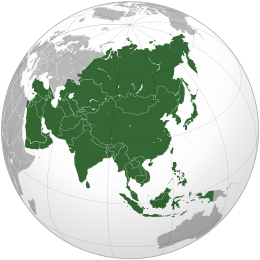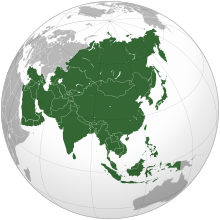آسيا
| په نوم د | |
|---|---|
| ترټولو لوړه څوکه |
| عمومي مالومات | |
|---|---|
| وګړو شمېر | |
| وګړنوم |
Aziaat — ázsiai — Asian — asiatisch — Asiatique — asiatico — asiatica — asiatici — asiatiche — asiáticu — asiática — asiáticos — asiátiques — азиаты — Aziano — एशियाई — آسيوي — Áiseach[۳] |
| فزیکي ځای |
| د ځای کچه |
|---|
| برخې | |
|---|---|
| برخه د |
| کورډينېشن |
|---|

آسيا د ځمکې تر ټولو ستر او د نفوس له پلوه ستره لويه وچه ده، چې په شمالي او ختيځه نيمه کره کې موقعيت لري. اسيا د ايوروايشيا په وچه کې د لويې وچې برخه د اروپا لويې وچې سره او د افرو-ايروايشيا په وچه کې له دواړو اروپا او افريقا سره شریکه ده. د اسيا مساحت ۴۴،۵۷۹،۰۰۰ کيلو مترمربع دی (۱۷۲۱۲۰۰۰ ميل مربع)، چې دا د ځمکې د وچې ټوله دېرش سلنه او د ځمکې د سطحې ټوله اته اعشاريه اووه سلنه ده. دا لويه وچه، چې له اوږدې مودې راهيسې د ډېرو انسانانو کور و، د ډېرو لومړيو تمدنونو کوربه هم و. د اسيا څلور اعشاريه پنځه ميليارده خلک (د ۲۰۱۹ ز د جون تر مياشتې پورې) د ټولې نړۍ د نفوس نږدې شپېته سلنه جوړوي.[۴][۵]
په عمومي ډول، د اسيا ختيځ لور ته ارام سمندرګی، سويل لور ته يې د هند سمندر او شمال لور ته يې شمالي کنګل بحر پروت دی. له اروپا سره د اسيا پوله يو تاريخي او کلتوري جوړښت دی، ځکه چې د دې دواړو لويو وچو تر منځ روښانه فزيکي او جغرافيايي جلا والی نه شته. تر يو بريده دا خپلسری جلاوالی دی او لومړی تصور يې په لرغوني کلاسيکي پړاو کې خوځېدلی دی. په دوو لويو وچو د ايروايشيا وېش، د ختيځ-لويديځ د کلتور، ادبياتو او توکميز توپير څرګندونه کوي، له دوی څخه ځينې يې د رښتیني وېش کرښې پر ځای، يوازې په نظري ډول وېشل شوې دي. د اسيا اوسنیو منل شوو پولو، اسيا ته د سويس کانال په ختيځ کې ځای ورکړی او په دې توګه يې له افريقا څخه جلا کړې ده. په ختيځ کې ترکي تنګي، د اورال غرونه او د اورال سيند دی، په سويل کې د قفقاز غرونه، د کسپين بحيره او تور سمندرګی دی، چې اسيا له اروپا څخه جلا کوي. [۶]
چين او هندوستان له ۱ څخه تر ۱۸۰۰ز کال پورې يو پر بل پسې د نړۍ له سترو اقتصادونو څخه وو. چين يو ستر اقتصادي ځواک و، چې ډېر يې د ختيځ خوا ته رامات کړل او د ډېرو لپاره د هندوستان د لرغوني کلتور افسانوي شتمني او غوړېدا د اسيا انځور وړاندې کاوه، چې اروپايي سوداګري، لوڅاوو او نېواک يې د ځان لور ته راجلباوه. د کولمبس له خوا له اروپا څخه د امريکا پر لور په ناڅاپي ډول د يوې لارې کشفېدل په داسې حال کې چې هغه د هندوستان پر لور د لارې په لټه کې و، د هندوستان د ژورې لېوالتيا څرګندونه کوي. د اسيا په دننه کې د ورېښمو لاره له ختيځ څخه د لوېديځ پر لور د سوداګرۍ بنسټيزه لاره وګرځېده، په داسې حال کې چې د مالاکا تنګی يوه بنسټيزه سمندري لاره وه. د شلمې پېړۍ په اوږدو کې اسيا د اقتصادي واک (په ځانګړي ډول ختيځې اسيا) او همدا راز د نفوس د زياتې ودې ښودنه وکړه، خو له هغه وخته اوس يې په عموم کې نفوس کمښت موندلی. اسيا د نړۍ د ډېرو اصلي دينونو د زېږېدو ځای دی، لکه هندو، زردشتي، جينيزم، بودايي، کنفوسيوس، تاويزم، مسيحيت، اسلام، سيک او داسې نور دينونه.[۷][۸][۹][۱۰][۱۱]
د اسيا اندازې او تنوع ته په کتنې سره، د اسيا معنا – هغه نوم چې تاریخ يې لرغوني پړاو ته ورګرځي – شونې ده چې د فزيکي جغرافيې په پرتله له انساني جغرافيې سره اړيکه ولري. توکميزو ډلو، کلتورونو، چاپيريال، اقتصاد، تاریخي اړيکو او حکومتي نظامونو ته په کتنې سره، اسيا په دننه کې د خپلو سيمو په منځ کې سره زيات توپيرونه لري. اسيا ډېر جلا جلا اقليمونه لري، چې په سويل کې د استوا له لیکې څخه پيل د منځني ختيځ له تودو سحراګانو څخه تېرېږې، په ختيځ او د لويې وچې په مرکز کې معتدلې سيمې دي او د سايبيريا پراخې نیمه قطبي او قطبي سيمې په کې شاملې دي.
پېژندنه او پولې
د اسيا-افريقا پولې
د افريقا او اسيا تر منځ پوله سور سمندرګی، د سويز خليج او د سويس کانال دی. په دې توګه مصر د لويو وچو تر منځ په پروت هېواد بدل شوی دی، په دې ډول چې د سينا ټاپووزمه په اسيا او نور هېواد په افريقا کې دی.[۱۲]
د اسيا او اروپا پوله
د يوناني جغرافيه پوهانو، لکه: اناګزيماينډر او هکاتايوس له امله، له ميلاد مخکې د لرغونې نړۍ درې اړخيز وېش، له ميلاد څخه مخکې له شپږمې پېړۍ څخه کارېده چې هغه اسيا، افريقا او اروپا وې. اناګزيماينډر د اروپا او اسیا تر منځ پوله د کوفاسيس سمندر (اوسنی ريوني سمندر) وګرځاوه، کوم چې د اوسنۍ جورجيا په قفقاز کې پروت دی (د هغې خولې څخه د «پوټي» په واسطه د تورسمندرګي په څنډو کې، د سورامي له لارې څخه د کورا سمندر په اوږدو کې تر کسپين بحېرې پورې)، هغه تړون چې هيوردوت له ميلاد مخکې په پنځمه پېړۍ کې ترې تقليد کاوه. په هلينستي پړاو کې، پر دې تړون بيا کتنه وشوه او پریکړه وشوه چې، د اسيا او اروپا تر منځ پوله به تانياس (اوسنی ډان سمندر) وي. دا هغه تړون دی چې، د پوزيدونيوس، سترابون او بطلميسوس په څېر د رومي پړاو لیکوالانو کارولی دی. [۱۳][۱۴][۱۵][۱۶][۱۷]
له تاريخي پلوه، د اروپا او اسيا تر منځ پولې اروپايي پوهانو ټاکلې وې. کله چې د روسې تزاروم پادشاه لوی پيټر د خپل سيال سويډن او عثماني سترواکۍ او سايبيريايي قبيلو وسله وال مقاومت ته په ختيځو سيمو کې ماتې ورکړه، په دې توګه يې په ۱۷۲۱ز کال کې د روسيې نوې سترواکي جوړه کړه چې، د اورال تر غرونو او له هغې ورهاخوا سیمو پورې غځېدلې وه، د ډان سمندر د شمالي اروپايانو لپاره د سرحد په توګه د منلو وړ نه و. په سترواکۍ کې د جغرافيې د نظرياتو وړاندې کوونکی د جګړې پخوانی بندي يو سويډنی تبعه و، چې په ۱۷۰۹ز کال کې د پولټاوا په جګړه کې نيول شوی و او په توبولسک کې وټاکل شو، هلته يې له «واسيلي تاتيشچف» د پيټر سايبيريايي مسئولينو سره اړیکې درلودې، هغه ته اجازه ورکړل شوه، چې د راتلونکي کتاب لپاره د چمتووالي په موخه جغرافيايي او د انسان پېژندنې مطالعات تر سره کړي.[۱۸]
د پيټر له مرګ پنځه کاله وروسته، په سويډن کې په ۱۷۳۰ز کال کې «فيليپ جان وان سټراهلنبرګ» نوی اطلس خپور کړ او د اورال غرونه يې د اسيا لپاره د پولو په توګه وړانديز کړل. تاتيشچوف اعلان وکړ چې، دا نظريه هغه «وان سټراهلنبرګ» ته ورکړې وه. «وان» د ايمبا سمندر د ښکته پولې په توګه وړانديز کړ. په راتلونکې پېړۍ کې بېلا بېل وړاندیزونه وشول، تر دې چې اورال سمندر د نولسمې پېړۍ په نيمايي کې پوله ومنل شوه. دا پوله په زور سره له تور سمندرګي څخه د کسپين بحېرې ته انتقال شوې وه، چېرته چې د اورال سيند بهيږي. د تور سمندرګي او کسپين تر منځ پوله په عمومي توګه، د قفقاز د غرونو د لوړې په اوږدو کې ټاکل شوې، که څه هم کله کله دا پوله نوره هم د شمال خوا ته ځي.[۱۹]
د اسيا –اوقيانوس پوله
د اسيا او اوقيانوس سيمې تر منځ پوله په عمومي توګهً په مالايي مجمع الجزاير کې ښودل کېږي. په اندونيزيا کې د مالوکو ټاپوګانو په اړه کله نا کله فکر کېږي چې، د سويل ختيځې اسيا په پوله پرتې دي چې نيو ګينيا د دې ټاپوګانو په ختيځ کې پروت دی او دا ټول د اوقيانوس برخه ده. د سويل ختيځې اسيا او اقيانوس اصطلاح، په نولسمه پېړۍ کې رامنځ ته شوې ده، له جوړېدو راهيسې، سره ډېرې توپير لرونکې جلا جلا جغرافيايي معناوې لري. په دې ټاکنه کې چې کوم ماليزيايي مجمع الجزاير اسيايي دي، بنسټيز عامل په هغه ځای کې د مختلفو سترواکيو د مستعمرو ځای دی (ټولې اروپايي مستعمرې نه). لويس او ويګن وايي چې: «اوسنيو پولو ته د سويل ختيځې اسيا راکوچني کول، يو تدريجي بهير و».[۲۰]
سرچينې
لويې وچې | ||||||||||||||||
|---|---|---|---|---|---|---|---|---|---|---|---|---|---|---|---|---|
| ||||||||||||||||
| همدارنگه وگورئ د نړۍ سيمې | ||||||||||||||||
- ↑ سرچينې تړی: https://www.workwithdata.com/placeasia. Retrieved: ۲۳ اکتوبر ۲۰۲۳.
- ↑ سرچينې تړی: http://megabook.ru/article/%D0%90%D0%B7%D0%B8%D1%8F%20(%D1%87%D0%B0%D1%81%D1%82%D1%8C%20%D1%81%D0%B2%D0%B5%D1%82%D0%B0).
- ↑ ذکر کېدنه: The National Terminology Database for Irish. اثر ژبه: ايرلينډي ژبه.
- ↑ "The World at Six Billion". UN Population Division. خوندي شوی له اصلي څخه په 5 March 2016., Table 2
- ↑ "Population of Asia. 2019 demographics: density, ratios, growth rate, clock, rate of men to women". www.populationof.net. بياځلي په 2 June 2019.
- ↑ National Geographic Atlas of the World (7th ed.). Washington, D.C.: National Geographic. 1999. ISBN 978-0-7922-7528-2. "Europe" (pp. 68–69); "Asia" (pp. 90–91): "A commonly accepted division between Asia and Europe is formed by the Ural Mountains, Ural River, Caspian Sea, Caucasus Mountains, and the Black Sea with its outlets, the Bosporus and Dardanelles."
- ↑ Nalapat, M. D. "Ensuring China's 'Peaceful Rise'". خوندي شوی له the original on 10 January 2010. بياځلي په 22 January 2016.
- ↑ Dahlman, Carl J; Aubert, Jean-Eric. China and the Knowledge Economy: Seizing the 21st Century. WBI Development Studies. World Bank Publications. Accessed January 22, 2016. World Bank Publications. 2000. ISBN 978-0-8213-5005-8. خوندي شوی له اصلي څخه په 4 March 2008. بياځلي په 9 November 2017.
{{cite book}}:|website=ignored (help) - ↑ "The Real Great Leap Forward". The Economist. 30 September 2004. خوندي شوی له اصلي څخه په 27 December 2016.
- ↑ [۱] Archived 20 November 2008 at the Wayback Machine.
- ↑ "Like herrings in a barrel". The Economist. No. Millennium issue: Population. 23 December 1999. خوندي شوی له اصلي څخه په 4 January 2010..
- ↑ "Suez Canal: 1250 to 1920: Middle East", Cultural Sociology of the Middle East, Asia, & Africa: An Encyclopedia, SAGE Publications, Inc., 2012, doi:10.4135/9781452218458.n112, ISBN 978-1-4129-8176-7, S2CID 126449508
- ↑ Histories 4.38. C.f. James Rennell, The Geographical System of Herodotus Examined and Explained, Volume 1, Rivington 1830, p. 244
- ↑ according to Strabo (Geographica 11.7.4) even at the time of Alexander, "it was agreed by all that the Tanais river separated Asia from Europe" (Script error: The function "Lang" does not exist.; c.f. Duane W. Roller, Eratosthenes' Geography, Princeton University Press, 2010, ISBN 978-0-691-14267-8, p. 57)
- ↑ W. Theiler, Posidonios. Die Fragmente, vol. 1. Berlin: De Gruyter, 1982, fragm. 47a.
- ↑ I. G. Kidd (ed.), Posidonius: The commentary, Cambridge University Press, 2004, ISBN 978-0-521-60443-7, p. 738.
- ↑ Geographia 7.5.6 (ed. Nobbe 1845, vol. 2, p. 178) Script error: The function "Lang" does not exist. "And [Asia] is connected to Europe by the land-strait between Lake Maiotis and the Sarmatian Ocean where the river Tanais crosses through."
- ↑ Lineback, Neal (9 July 2013). "Geography in the News: Eurasia's Boundaries". National Geographic. خوندي شوی له the original on 8 May 2016. بياځلي په 9 June 2016.
- ↑ Lewis & Wigen 1997, pp. 27–28
- ↑ Lewis & Wigen 1997, pp. 170–173
- هغه پاڼي چې د P138 ځانګړتیاوي کاروي
- هغه پاڼي چې د P610 ځانګړتیاوي کاروي
- هغه پاڼي چې د ويکيډېټا مالومات کاروي
- هغه پاڼي چې د P1082 ځانګړتیاوي کاروي
- هغه پاڼي چې د P1549 ځانګړتیاوي کاروي
- هغه پاڼي چې د P706 ځانګړتیاوي کاروي
- هغه پاڼي چې د P2046 ځانګړتیاوي کاروي
- هغه پاڼي چې د P527 ځانګړتیاوي کاروي
- هغه پاڼي چې د P361 ځانګړتیاوي کاروي
- هغه پاڼې چي بې پاراميټره مالوماتبکس کېټ کاروي
- هغه پاڼې چي مالوماتبکس کېټ کاروي
- هغه پاڼې چې یو خصوصیت کارويP242
- آسيا
- لويې وچې
- Pages using the JsonConfig extension
- CS1 errors: periodical ignored
- د وېبپاڼيزې کينډۍ لارښوونيز لینکونه
- نخشه لرونکي مخونه













